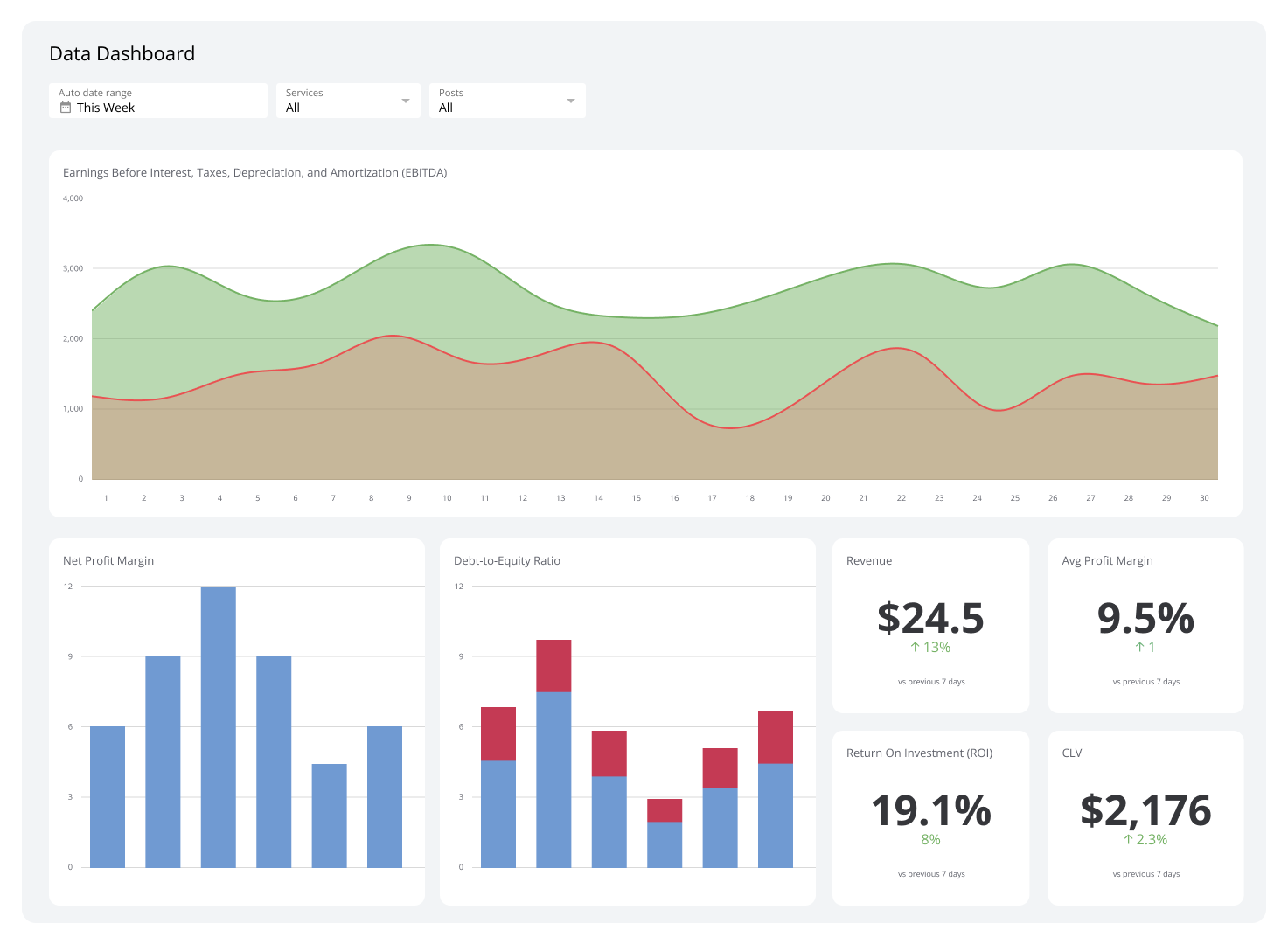SaaS Metrics Cheat Sheet

Published 2022-04-28
Summary - SaaS metrics are used by SaaS (software-as-a-service) companies to measure and track growth. From revenue to marketing, these metrics help a company establish benchmarks, set KPIs, and prepare for the future.
SaaS metrics are used by SaaS (software-as-a-service) companies to measure and track growth. From revenue to marketing, these metrics help a company establish benchmarks, set KPIs, and prepare for the future.
The application of these metrics will vary from business to business, but the fundamental purpose is universal: tracking your full funnel business performance.
This cheat sheet is going to give you the top SaaS metrics to track for your business, including: how to apply it, what the metric tells you, and the intended outcome of measuring each metric. I’ve also included the formula to calculate each metric, but tracking these metrics is even easier when you add them to a dashboard.
Whether you’re a founder, a finance leader, a marketer, a sales rep, or anywhere in between, each of these metrics is a key part of your full business funnel.
This is your SaaS metrics cheat sheet.
Here are the metrics we’ll cover in this article:
- Monthly Recurring Revenue
- Annual Recurring Revenue
- Churn
- Customer Retention Rate
- Sales Cycle Length
- Weighted Annual Contract Value (ACV)
- Customer Acquisition Cost (CAC)
- Customer Lifetime Value (LTV)
- Net Promoter Score (NPS)
- Product Qualified Leads (PQLs)
SaaS Revenue Metrics
Revenue metrics are the heart of your business. Money is what brings you and your company growth, and arguably, success. Finance metrics are a key component of your business funnel.
Your revenue metrics are a signal for business performance. When you dive into your revenue metrics, you’ll see one of three things: growth, stability, or areas of concern. Revenue metrics will help you dig deeper into your systems and processes to fix a problem. For example, are you seeing a lot of churn? Dig deeper into why: Is there an issue with your product? Has your success team had an increase in support tickets lately?
Revenue metrics should be used as a way to signal business health, like signs of success or early warning signs so you’re never caught off guard.
1. Monthly Recurring Revenue
The total monthly dollar amount of your subscription revenue. You can segment your MRR to see what amount is expansion, new business, churn, or contraction. MRR is critical to track; it’s the money coming in the door every month so you can sustain your business.
Calculate it:
ƒ Sum(Recurring Revenue irrespective of billing interval expressed as a monthly value)
2. Annual Recurring Revenue
The total annual dollar value of your subscription revenue. This metric is an accurate depiction of your revenue and will help you forecast your growth on a larger scale. ARR is a holistic way of looking at your business growth, whereas MRR is a more granular way of looking at your incoming revenue.
Calculate it:
ƒ Sum(Recurring Revenue irrespective of billing interval expressed as an annual value)
3. Churn
SaaS businesses rely on subscription revenue, so when a customer leaves, it’s a direct hit to your MRR. The cost of acquiring a new customer is almost always more than retaining one, so churn is an important SaaS revenue metric for forecasting growth. Churn is an important metric across departments—it’s something that your leadership team right down to your marketing team should be keeping an eye on.
Calculate it:
ƒ Count(Churned Customers This Period) / (Total # of Customers at the Beginning of the Period)
SaaS Sales and Support Metrics
For SaaS businesses, sales and support are the pillars of your business. Sales brings in new customers or works on expansion for existing customers and your support team is there for your customers throughout their entire journey.
4. Customer Retention Rate
Customer retention has a direct link to revenue. Retaining customers = less money spent to acquire new customers and more opportunity for expansion and renewals. This is a metric you want to watch.
Calculate it:
ƒ (Count(Customers End of Period) - Count(Acquired Customers)) / Count(Customers Beginning of Period)
5. Sales Cycle Length
Sales cycle length is the number of days or months it takes on average to close a deal. SaaS sales teams can use this metric when creating a sales forecast, measuring efficiency, or speaking with investors.
Calculate it:
ƒ Count(Days to Close All Deals) / Count(Number of Deals)
6. Weighted Annual Contract Value (ACV)
Weighted ACV, different from ACV, is the average contract dollar value with a weighted average proportionate to the value of the contract. Calculating ACV as a weighted value is helpful for companies that have varying customer concentration. When you use weighted ACV, your ACV is not skewed by contracts with a disproportionately high or low dollar value.
Calculate it:
ƒ ((Contract Value 1 * Percentage of Total Contract Value) + (Contract Value 2 * Percentage of Total Contract Value))
SaaS Marketing and Growth Metrics
Marketing’s goal is to attract potential customers. For SaaS marketers, it can be a challenge. Products and services change or release new features or updates, have a niche audience, or exist in the cloud, therefore there’s no physical product. All of these attributes can make SaaS marketing challenging (and honestly, quite fun!)
This is partially what makes SaaS marketing and growth metrics important to understand and track. When the landscape is evolving and changing, your data is a North Star to always bring you back home.
7. Customer Acquisition Cost (CAC)
How much does it actually cost to acquire a customer? We know from earlier in the article that new customers are often more costly to acquire than retaining a current customer. Customer acquisition cost (CAC) is going to assign a dollar value for acquiring a new customer (fully loaded costs, including sales and marketing). CAC is important to measure in aggregate but also by market segment. Is one segment more costly than another? Use this metric to determine your efficiency and profitability in each market segment, territory, or as a whole.
Calculate it:
ƒ Sum(Sales Costs + Marketing Costs) / Count(New Customers)
8. Customer Lifetime Value (LTV)
Growth is rooted in revenue. The lifetime value of a customer is the total amount of revenue that a business can expect from a single customer account. Marketers can use this metric to identify their most valuable customer segments.
Calculate it:
ƒ (Average Revenue Per Account) X (1 / Logo Churn Rate) X (Gross Margin %)
9. Net Promoter Score (NPS)
Net Promoter Score measures a customer’s willingness to promote your product or service to colleagues or friends. Marketers know that word-of-mouth is one of the most effective marketing strategies out there! Measuring your Net Promoter Score will help you determine your detractors from your promoters so you can focus your growth efforts with your promoters in mind.
Calculate it:
ƒ (% Promotors) - (% Detractors)
10. Product Qualified Leads (PQLs)
PQLs measures the quality of potential customers based on their usage and actions in your product. Like marketing qualified leads, PQLs are assigned based on certain actions that indicate high-intent to purchase the product. PQLs are said to be of better lead quality than MQLs or SQLs due to their in-product experience and demonstrated interest outside of page visits or form completions.
Calculate it:
ƒ Count(PQLs)
Bonus SaaS metrics that you should track on your dashboard
There are hundreds of metrics to choose from, but the hardest part can be narrowing down which ones. Here are a couple of bonus metrics you can track that are applicable to forecasting your revenue and achieving your growth targets.
- DAU/MAU Ratio: Get the definition and formula
- Expansion MRR Growth Rate: Get the definition and formula
- Net Revenue Retention Rate: Get the definition and formula
- Time to Value: Get the definition and formula
Get started today and track all of these metrics on a PowerMetrics dashboard for full funnel business performance monitoring.





